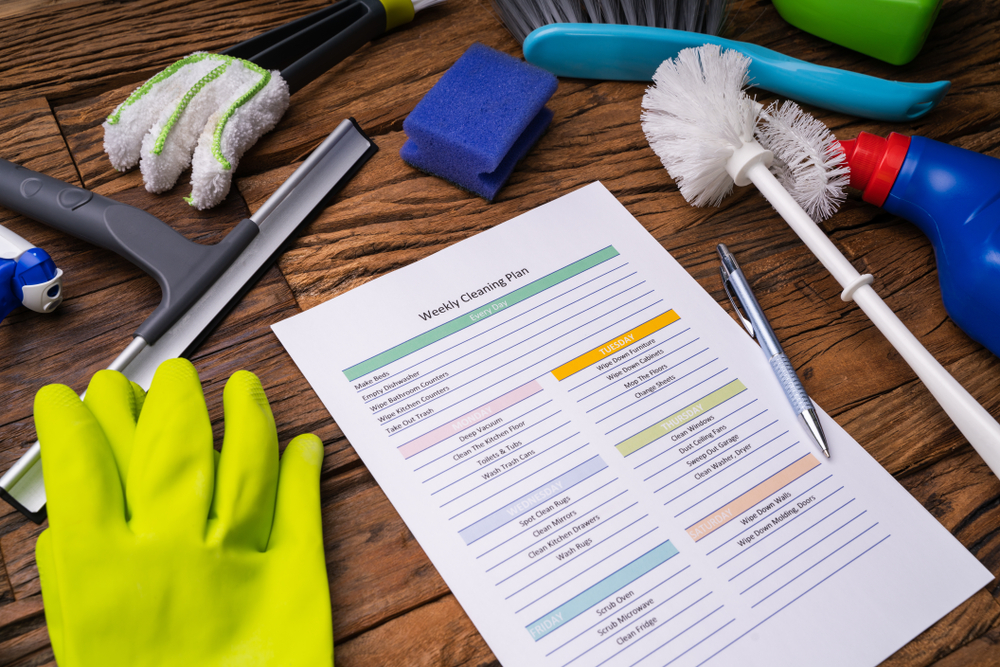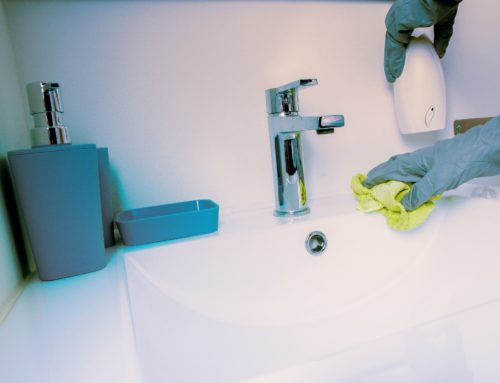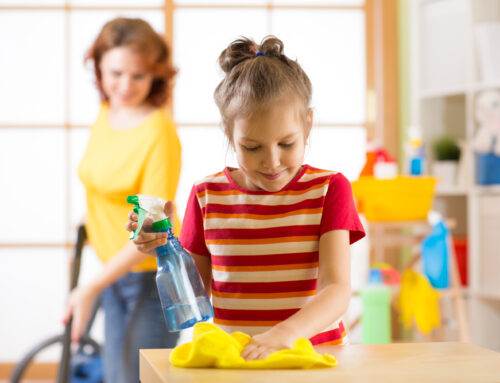
How to Create a Cleaning Schedule: Stay Organized and Efficient
Maintaining a clean and organized home is essential not only for our physical well-being but also for our mental and emotional health. However, without a proper cleaning schedule in place, it’s easy to become overwhelmed and let cleaning tasks pile up. By creating a personalized cleaning schedule, you can effectively manage your cleaning responsibilities and ensure that your home remains tidy and welcoming. Let’s dive into the process of creating a cleaning schedule that suits your needs and lifestyle.
The Importance of a Cleaning Schedule
A cleaning schedule serves as a roadmap for your cleaning tasks, providing structure and guidance on what needs to be done and when. Without a schedule, it’s easy to procrastinate or overlook certain areas, leading to a buildup of dirt and clutter. By establishing a cleaning routine, you can maintain a consistently clean home and avoid the stress and frustration of last-minute cleaning sprees. A cleaning schedule also helps in distributing tasks evenly throughout the week, preventing overwhelming cleaning sessions.
Assessing Your Cleaning Needs
Before diving into creating a cleaning schedule, take some time to assess your cleaning needs. Consider the size of your home, the number of occupants, and your lifestyle. Are you a pet owner? Do you have children? Understanding your specific requirements will help you tailor your cleaning schedule to address the unique challenges and priorities of your household. This assessment will guide you in determining the frequency and intensity of your cleaning tasks.
Setting Realistic Cleaning Goals
When creating a cleaning schedule, it’s important to set realistic goals that you can consistently achieve. Assess the time and energy you can realistically allocate to cleaning each day or week. Be honest with yourself about your limitations and commitments. Setting unattainable goals will only lead to frustration and demotivation. Start with small, achievable goals and gradually increase the intensity or frequency of your cleaning tasks as you become more comfortable with your schedule.
Creating a Weekly Cleaning Schedule
A weekly cleaning schedule serves as the foundation of your cleaning routine. Start by listing all the cleaning tasks you need to accomplish throughout the week. Break down the tasks into specific areas or rooms of your home. Consider the time and effort required for each task. For example, vacuuming the entire house may take longer than wiping down countertops. Distribute the tasks evenly throughout the week, ensuring that you don’t overwhelm yourself on a single day.
To make it easier, here’s an example of a weekly cleaning schedule:
| Day | Cleaning Tasks |
|---|---|
| Monday | Vacuuming and dusting |
| Tuesday | Kitchen cleaning and organization |
| Wednesday | Bathroom cleaning |
| Thursday | Laundry and bedroom cleaning |
| Friday | Living room cleaning |
| Saturday | Outdoor cleaning and maintenance |
| Sunday | Rest day |
Creating a visually appealing table like the one above can help you keep track of your cleaning tasks at a glance. Adjust the tasks and days according to your preferences and needs. The goal is to establish a consistent routine that you can easily follow.
Daily Cleaning Tasks: Small Steps, Big Impact
In addition to your weekly cleaning schedule, it’s important to incorporate daily cleaning tasks into your routine. These small tasks can significantly contribute to the overall cleanliness of your home and prevent the accumulation of dirt and clutter. Some daily cleaning tasks you can consider are:
- Making the bed: Start your day by making your bed. It sets a positive tone for the rest of the day and instantly makes your bedroom look tidier.
- Wiping down surfaces: Take a few minutes each day to wipe down kitchen countertops, tables, and other frequently used surfaces. This prevents the buildup of dust and keeps your home looking fresh.
- Doing the dishes: Make it a habit to wash the dishes or load the dishwasher after each meal. This prevents dirty dishes from piling up and maintains a clean and organized kitchen.
- Putting things away: Develop the habit of putting items back in their designated places after use. This simple step reduces clutter and saves you time when cleaning.
- Sweeping or vacuuming high-traffic areas: Focus on areas that receive the most foot traffic, such as entryways or living room floors. Regularly sweeping or vacuuming these areas prevents dirt from spreading throughout your home.
By incorporating these small cleaning tasks into your daily routine, you can maintain a consistently clean home without feeling overwhelmed by a massive cleaning session.
Allocating Time for Deep Cleaning
While your weekly and daily cleaning tasks focus on surface cleaning, it’s important to allocate time for deep cleaning as well. Deep cleaning involves more thorough and intensive cleaning tasks that target areas or items that may not require daily attention. Examples of deep cleaning tasks include cleaning windows, scrubbing grout, dusting blinds, and organizing closets.
To ensure that deep cleaning doesn’t become neglected, designate specific days or weekends for tackling these tasks. For instance, you can set aside the first Saturday of every month for deep cleaning. This way, you can allocate a dedicated block of time to focus on these more time-consuming and detail-oriented tasks.
By incorporating deep cleaning into your schedule, you ensure that every nook and cranny of your home receives the attention it needs, leading to a cleaner and more inviting living environment.
The Power of Decluttering: Simplify Your Cleaning Routine
One of the most effective ways to streamline your cleaning routine and make it more efficient is by decluttering your home. Clutter not only makes cleaning more difficult and time-consuming but also contributes to a sense of disorganization and chaos.
Take the time to declutter each room of your home. Start by getting rid of items you no longer need or use. Sort them into categories such as donation, recycling, or trash. Once you’ve decluttered, assign specific storage spaces for the remaining items. This step not only helps you keep things organized but also makes cleaning more efficient since there are fewer items to move and clean around.
Incorporating regular decluttering sessions into your cleaning schedule helps prevent the accumulation of unnecessary items and ensures that your home remains tidy and clutter-free.
Incorporating Cleaning Zones for Efficiency
To further enhance the efficiency of your cleaning routine, consider dividing your home into cleaning zones. Cleaning zones are specific areas or rooms that you focus on during designated cleaning sessions. By focusing on one zone at a time, you can concentrate your efforts and complete tasks more quickly.
Divide your home into zones based on your needs and preferences. For example, you can have a kitchen zone, a living room zone, a bathroom zone, and so on. Assign specific days or times to clean each zone, ensuring that you cover all areas of your home over the course of a week or month.
Cleaning zones not only make your cleaning routine more manageable but also provide a sense of accomplishment as you complete tasks within each zone.
Utilizing Cleaning Tools and Supplies
Having the right cleaning tools and supplies can make a significant difference in the effectiveness and efficiency of your cleaning routine. Before you start creating your cleaning schedule, take stock of your cleaning arsenal and ensure that you have all the necessary tools and supplies on hand.
Some essential cleaning tools and supplies include:
- Vacuum cleaner: A high-quality vacuum cleaner is essential for efficiently cleaning carpets, rugs, and hard floors.
- Microfiber cloths: These versatile and reusable cloths are perfect for dusting, wiping surfaces, and cleaning glass without leaving streaks.
- Mop and bucket: For hard floors, a mop and bucket make cleaning a breeze. Opt for a mop with a detachable, machine-washable head for convenience.
- Cleaning solutions: Invest in a range of effective and safe cleaning solutions for different surfaces and purposes. Examples include all-purpose cleaners, glass cleaners, and disinfectants.
- Broom and dustpan: For quick sweeping tasks, a broom and dustpan are essential tools to have on hand.
- Scrub brushes: Different types and sizes of scrub brushes are useful for tackling tough stains and grime in various areas of your home, such as the bathroom or kitchen.
Having these tools readily available ensures that you can efficiently clean and maintain your home according to your schedule.
Establishing Maintenance Routines
In addition to regular cleaning tasks, establishing maintenance routines can help you keep your home clean and organized in the long run. Maintenance routines involve simple, recurring tasks that prevent dirt and clutter from accumulating over time. By incorporating these routines into your cleaning schedule, you can stay on top of regular maintenance and minimize the need for intensive cleaning sessions.
Some examples of maintenance routines include:
- Regularly wiping down kitchen appliances and surfaces to prevent grease buildup.
- Dusting frequently used surfaces and furniture to keep them clean and allergen-free.
- Checking and replacing air filters regularly to maintain clean and healthy indoor air quality.
- Inspecting and maintaining plumbing fixtures to prevent leaks and water damage.
- Laundering and changing bedding and linens on a scheduled basis.
- Rotating and flipping mattresses to ensure even wear and extend their lifespan.
These maintenance tasks may seem small, but they contribute to the overall cleanliness and functionality of your home. Incorporating them into your cleaning schedule ensures that they don’t get overlooked.
Streamlining Laundry: Tips for Efficiency
Laundry is a never-ending task in most households. To make your laundry routine more efficient and manageable, consider implementing the following tips:
- Sort laundry by color and fabric type: Sorting your laundry before washing prevents color bleeding and ensures that delicate items are treated with care.
- Optimize your washing machine: Familiarize yourself with the settings and features of your washing machine to ensure you’re using the most appropriate cycle and water temperature for each load.
- Use laundry baskets or hampers: Have designated baskets or hampers for different types of laundry, such as whites, darks, and delicates. This makes sorting easier and keeps your laundry area organized.
- Make use of stain removal techniques: Learn effective stain removal methods to tackle common stains. Treating stains promptly before they set can save you time and effort in the long run.
- Fold and put away laundry immediately: Avoid leaving clean laundry piled up for days. Take the time to fold and put away each load as soon as it’s done. This prevents wrinkles and clutter.
By implementing these tips, you can streamline your laundry routine and ensure that your clothes are consistently clean and well-maintained.
Kitchen Cleaning: Keeping the Heart of Your Home Spotless
The kitchen is often considered the heart of the home, and it’s crucial to keep it clean and hygienic. Here are some tips to help you maintain a spotless kitchen:
- Clean spills and messes promptly: Spills and messes can quickly accumulate in the kitchen. By cleaning them up immediately, you prevent stains and ensure a clean cooking environment.
- Wipe down countertops and surfaces daily: Make it a habit to wipe down your countertops and other surfaces after each meal preparation. This prevents the buildup of dirt and bacteria.
- Deep clean appliances regularly: Appliances like the oven, refrigerator, and microwave can accumulate grease, food residue, and unpleasant odors. Schedule regular deep cleaning sessions for these appliances to keep them in top condition.
- Scrub the sink and drain: Your kitchen sink can harbor bacteria and odors if not cleaned regularly. Use a mild abrasive cleaner or baking soda to scrub the sink and clean the drain to keep them fresh and hygienic.
- Empty and clean the trash regularly: Dispose of kitchen waste promptly to prevent unpleasant odors and pest problems. Wipe down the trash can regularly to maintain cleanliness.
By following these kitchen cleaning tips, you can ensure that your kitchen remains a clean and inviting space for cooking and gathering.
Bathroom Cleaning: Maintaining a Fresh and Hygienic Space
Keeping your bathroom clean is crucial for maintaining hygiene and preventing the buildup of mold and mildew. Here are some tips for an efficient bathroom cleaning routine:
- Use an all-purpose cleaner: An all-purpose cleaner is handy for wiping down bathroom surfaces, including countertops, sinks, and shower tiles. Make sure to choose a cleaner that is suitable for the specific materials in your bathroom.
- Scrub the toilet regularly: The toilet is one of the most important fixtures to clean regularly. Use a toilet brush and a toilet cleaner to scrub the bowl and remove any stains or buildup.
- Clean the shower and bathtub: Soap scum and mineral deposits can accumulate on shower walls and bathtub surfaces. Use a scrub brush or sponge and a suitable cleaner to remove these deposits and keep your shower and bathtub clean.
- Wipe down mirrors and glass surfaces: Use a glass cleaner and a lint-free cloth to clean mirrors and glass surfaces in your bathroom. This will ensure a streak-free shine.
- Don’t forget about the floors: Sweep or vacuum the bathroom floor to remove any dust or hair. Then mop the floor with a suitable cleaner to ensure it’s clean and hygienic.
- Regularly clean bathroom accessories: Towel racks, soap dishes, and toothbrush holders can accumulate dirt and grime over time. Clean these accessories regularly to maintain cleanliness and prevent the spread of germs.
- Pay attention to ventilation: Proper ventilation is crucial in a bathroom to prevent mold and mildew growth. Ensure that your bathroom has good airflow by using an exhaust fan or opening windows during and after showering.
By following these bathroom cleaning tips, you can maintain a fresh and hygienic space that promotes your well-being.
Bedroom Cleaning: Creating a Serene and Relaxing Environment
A clean and organized bedroom promotes better sleep and relaxation. Here are some tips to help you keep your bedroom clean and serene:
- Make your bed daily: Start your day by making your bed. This simple task instantly makes your bedroom look tidier and sets a positive tone for the rest of the day.
- Dust and wipe surfaces: Dust surfaces such as nightstands, dressers, and shelves regularly to prevent dust buildup. Use a microfiber cloth or a duster to effectively remove dust from these surfaces.
- Vacuum or sweep the floor: Keep your bedroom floor clean by regularly vacuuming or sweeping. Pay attention to corners and under furniture where dust and debris can accumulate.
- Launder bedding regularly: Sheets, pillowcases, and blankets should be laundered on a regular basis to maintain cleanliness and hygiene. Follow the care instructions on your bedding for best results.
- Declutter and organize: Take a few minutes each day to declutter and organize your bedroom. Put away items that are out of place and ensure that everything has its designated spot.
- Clean windows and curtains: Clean windows and curtains not only enhance the appearance of your bedroom but also improve indoor air quality. Use a glass cleaner for windows and follow the care instructions for your curtains.
- Rotate and flip your mattress: To ensure even wear and extend the lifespan of your mattress, rotate and flip it regularly. This helps prevent sagging and maintains the comfort and support of your bed.
By following these bedroom cleaning tips, you can create a peaceful and inviting space that promotes restful sleep and relaxation.
Living Room Cleaning: Promoting Comfort and Order
The living room is often the center of activity in a home, making regular cleaning essential. Here are some tips to help you keep your living room clean and comfortable:
- Dust surfaces and furniture: Dust surfaces, shelves, and furniture regularly to prevent dust buildup. Use a microfiber cloth or a duster to effectively capture dust particles.
- Vacuum upholstery and carpets: Upholstered furniture and carpets can harbor dust, pet hair, and allergens. Use a vacuum cleaner with upholstery attachments to remove debris and keep these surfaces clean.
- Clean and polish wooden furniture: If you have wooden furniture in your living room, clean and polish it regularly to maintain its appearance and protect the wood.
- Wipe down electronics and TV screens: Electronics such as televisions, computers, and sound systems can collect dust and fingerprints. Use a soft, lint-free cloth to wipe down these devices and screens.
- Launder and fluff cushions: If your living room has cushions or throw pillows, launder them regularly according to the care instructions. Fluff them to maintain their shape and comfort.
- Organize and declutter: Keep your living room tidy by organizing and decluttering regularly. Put away items that are out of place and ensure that everything has its designated storage space.
- Clean windows and window treatments: Clean windows and window treatments improve the overall appearance of your living room and allow natural light to brighten the space. Use a glass cleaner for windows and follow the care instructions for your window treatments.
By following these living room cleaning tips, you can create a clean and inviting space where you can relax and enjoy quality time with family and friends.
Cleaning for Guests: Preparing for Special Occasions
Hosting guests can be a joyous occasion, but it also means putting extra effort into cleaning and preparing your home. Here are some tips to help you clean and prepare your home for guests:
- Create a cleaning checklist: Before your guests arrive, create a checklist of cleaning tasks that need to be done. This ensures that you don’t overlook anything and helps you stay organized.
- Focus on high-traffic areas: Pay extra attention to high-traffic areas such as the entryway, living room, kitchen, and guest bathroom. These areas are likely to receive the most attention from your guests.
- Declutter and create a welcoming environment: Remove any unnecessary clutter and create a welcoming atmosphere in your home. Arrange furniture in a way that encourages conversation and provides comfortable seating for your guests.
- Freshen up guest bedding: Launder and change the bedding in the guest bedroom to ensure it’s fresh and inviting. Provide extra blankets and pillows for added comfort.
- Stock up on essentials: Make sure your guest bathroom is stocked with essentials such as toilet paper, hand soap, and clean towels. Consider adding extra toiletries like travel-sized shampoo and conditioner for your guests’ convenience.
- Clean and tidy common areas: Ensure that common areas such as the living room, dining room, and kitchen are clean and presentable. Wipe down surfaces, vacuum or sweep floors, and tidy up any clutter.
- Add personal touches: Consider adding personal touches to make your guests feel welcome, such as fresh flowers, scented candles, or a welcome note.
By following these tips, you can create a clean and welcoming environment for your guests, ensuring a memorable and enjoyable visit.
Weekly and Monthly Deep Cleaning Tasks
In addition to your regular cleaning routine, it’s important to incorporate weekly and monthly deep cleaning tasks into your schedule. These tasks target areas or items that may not require frequent cleaning but still require attention to maintain cleanliness and hygiene. Here are some examples of weekly and monthly deep cleaning tasks:
Weekly Deep Cleaning Tasks:
- Clean the inside of the refrigerator: Remove all items from the refrigerator, discard expired items, and wipe down the interior surfaces.
- Dust and clean ceiling fans: Use a duster or a vacuum attachment to clean ceiling fans and remove dust buildup.
- Scrub and disinfect trash cans: Empty and clean trash cans thoroughly, both inside and outside, to eliminate odors and prevent the spread of germs.
- Vacuum and flip mattresses: Vacuum your mattresses to remove dust and allergens. Flip or rotate the mattress to ensure even wear.
- Clean and descale coffee makers: Follow the manufacturer’s instructions to clean and descale your coffee maker to ensure optimal performance and a clean cup of coffee.
Monthly Deep Cleaning Tasks:
- Clean window sills and tracks: Remove dirt and debris from window sills and tracks using a vacuum cleaner or a soft brush.
- Deep clean carpets and rugs: Use a carpet cleaner or hire a professional service to deep clean your carpets and rugs to remove deep-seated dirt and stains.
- Wash curtains or blinds: Launder curtains or wipe down blinds to remove dust and refresh their appearance.
- Dust and clean light fixtures: Remove dust from light fixtures and clean glass shades or covers to ensure optimal brightness and appearance.
- Clean and organize closets: Declutter and organize your closets, wiping down shelves and vacuuming the floors to keep them clean and orderly.
By incorporating these weekly and monthly deep cleaning tasks into your schedule, you can maintain a clean and well-maintained home.
Creating a Family Cleaning Routine
Involving your family members in the cleaning routine not only lightens the workload but also promotes a sense of responsibility and teamwork. Here are some tips for creating a family cleaning routine:
- Schedule regular family cleaning sessions: Set aside specific times each week or month for family cleaning sessions. This can be a designated time on weekends or a specific day of the week when everyone contributes to cleaning tasks.
- Assign age-appropriate tasks: Delegate cleaning tasks based on your family members’ abilities and ages. Younger children can assist with simple tasks like tidying up toys, while older children and teenagers can handle more complex tasks.
- Make it fun and rewarding: Turn cleaning into a game or challenge to make it more enjoyable. Set timers and see who can complete tasks the fastest, or create a reward system where everyone receives a small treat or privilege after completing their tasks.
- Lead by example: Show your family members the importance of cleanliness by leading by example. When they see you actively participating in the cleaning routine, they are more likely to follow suit.
- Have clear expectations and guidelines: Clearly communicate the cleaning tasks and expectations to your family members. Provide guidance and demonstrate the proper techniques for each task to ensure they are done effectively.
- Celebrate accomplishments: Acknowledge and celebrate the efforts of your family members in maintaining a clean and organized home. This encourages a positive and supportive environment.
By involving your family members in the cleaning routine, you not only share the workload but also instill valuable life skills and promote a sense of responsibility within your household.
Teaching Children Cleaning Habits: Fun and Educational Strategies
Teaching children cleaning habits from an early age helps instill a sense of responsibility and establishes good cleaning practices for the future. Here are some fun and educational strategies for teaching children cleaning habits:
- Turn cleaning into a game: Make cleaning a fun and engaging activity by turning it into a game. Set a timer and challenge your children to complete tasks before the time runs out. Offer small rewards or incentives for a job well done.
- Make cleaning tools child-friendly: Provide child-sized cleaning tools that are safe and easy for children to use. This can include small brooms, dustpans, and dusters. Having tools that are their size makes cleaning more enjoyable for children.
- Create a cleaning chart: Create a colorful and interactive cleaning chart or checklist that your children can use to track their cleaning tasks. Allow them to check off completed tasks or use stickers as rewards.
- Use storytelling: Incorporate storytelling into your cleaning routine. Create characters or superheroes who love to keep their spaces clean and use their stories to inspire your children to embrace cleaning habits.
- Make it a team effort: Assign tasks that allow siblings to work together and collaborate. This promotes teamwork and creates a sense of camaraderie in cleaning activities.
- Provide guidance and supervision: Offer guidance and supervision as your children learn cleaning tasks. Demonstrate the proper techniques and provide constructive feedback to help them improve their skills.
By making cleaning fun and educational, you can instill good cleaning habits in your children that will benefit them throughout their lives.
Delegating Tasks: Sharing the Cleaning Responsibilities
Sharing the cleaning responsibilities among family members or housemates lightens the workload and promotes a sense of fairness and cooperation. Here are some tips for delegating cleaning tasks:
- Communicate and discuss responsibilities: Have an open conversation with your family members or housemates to discuss cleaning responsibilities. Clearly communicate expectations and ensure that everyone is on the same page.
- Assign tasks based on preferences and abilities: Take into account the preferences and abilities of each person when assigning cleaning tasks. Some individuals may enjoy certain tasks more than others or have specific skills that make them more efficient in certain areas.
- Rotate tasks regularly: To ensure fairness, rotate the cleaning tasks among family members or housemates on a regular basis. This prevents one person from being burdened with the same tasks all the time.
- Create a cleaning schedule or chore chart: Develop a cleaning schedule or chore chart that outlines the assigned tasks and the frequency of completion. Display it in a visible location to serve as a reminder for everyone.
- Offer flexibility and support: Be flexible and understanding when it comes to cleaning responsibilities. Life can get busy, and circumstances may change, so be willing to provide support or adjust the schedule as needed.
- Express appreciation and gratitude: Recognize and express gratitude for the efforts of each person in contributing to the cleaning responsibilities. A simple “thank you” goes a long way in promoting a positive and cooperative environment.
By delegating cleaning tasks and sharing responsibilities, you create a more harmonious living environment and ensure that the cleaning workload is distributed evenly.
Staying Motivated: Rewarding Yourself for a Job Well Done
Staying motivated and consistent with your cleaning routine can be challenging at times. However, by incorporating rewards and incentives, you can maintain your motivation and make cleaning more enjoyable. Here are some ideas for rewarding yourself for a job well done:
- Treat yourself to something you enjoy: After completing a cleaning task or reaching a cleaning milestone, treat yourself to something you enjoy. It can be a favorite snack, a cup of coffee at a local café, or a relaxing bath.
- Take breaks and indulge in leisure activities: Break up your cleaning sessions with short breaks to engage in leisure activities that you enjoy. It can be reading a chapter of a book, listening to music, or watching a short episode of your favorite TV show.
- Create a cleaning playlist: Make cleaning more enjoyable by creating a playlist of upbeat and energizing songs that you love. Listening to music while cleaning can boost your mood and motivation.
- Set goals and track progress: Set cleaning goals for yourself and track your progress. This can be completing a certain number of tasks in a day or achieving a specific level of cleanliness. Celebrate your achievements when you reach these goals.
- Reward yourself with a clean and organized space: Remind yourself of the benefits of a clean and organized home. Take a moment to appreciate the fresh and inviting environment you’ve created for yourself and your family.
- Involve others in your rewards: Share your cleaning accomplishments with family members or friends and celebrate together. It can be a small gathering or a special treat to acknowledge your dedication and hard work.
By rewarding yourself for a job well done, you create positive associations with cleaning and maintain the motivation to consistently keep your home clean and organized.
Troubleshooting: Overcoming Challenges and Sticking to Your Schedule
Despite your best efforts, challenges may arise that make it difficult to stick to your cleaning schedule. Here are some common challenges and strategies to overcome them:
- Lack of time: If you’re struggling to find time for cleaning, try breaking down tasks into smaller, more manageable chunks. Focus on completing one or two tasks each day, rather than trying to tackle everything at once. You can also consider delegating tasks to other family members or hiring professional help if necessary.
- Lack of motivation: It’s normal to feel unmotivated at times, but finding ways to make cleaning more enjoyable can help. Play your favorite music, listen to podcasts or audiobooks while cleaning, or set a timer and challenge yourself to complete tasks within a certain time frame. You can also create a reward system for yourself, as mentioned earlier, to stay motivated.
- Procrastination: If you find yourself procrastinating on cleaning tasks, try setting specific deadlines for each task and hold yourself accountable. Break down larger tasks into smaller, more manageable steps to make them less daunting. Creating a cleaning checklist or using a cleaning app can also help you stay organized and focused.
- Unexpected disruptions: Life can be unpredictable, and unexpected events or emergencies may disrupt your cleaning routine. When this happens, be flexible and adjust your schedule accordingly. Remember that it’s okay to deviate from your schedule occasionally as long as you get back on track as soon as possible.
- Overwhelming workload: If you feel overwhelmed by the amount of cleaning tasks, consider reevaluating your cleaning schedule and prioritizing essential tasks. Focus on maintaining cleanliness in high-traffic areas and tackle less critical tasks when you have more time and energy.
- Lack of support: If you feel like you’re the only one responsible for cleaning, communicate your concerns with family members or housemates. Express the importance of shared responsibility and work together to develop a cleaning routine that everyone can participate in. Consider holding regular family meetings to discuss cleaning tasks and ensure everyone is on the same page.
Remember that consistency is key when it comes to sticking to your cleaning schedule. Even if you encounter challenges along the way, the important thing is to maintain a consistent effort and adapt your schedule as needed.
Time-Saving Tips: Cleaning Hacks for Busy Individuals
For busy individuals, finding ways to save time on cleaning can make a significant difference. Here are some time-saving tips and cleaning hacks to help you efficiently maintain a clean home:
- Multitask while cleaning: Make use of downtime while cleaning. For example, while waiting for a cleaning solution to sit or a load of laundry to finish, you can tidy up or wipe down surfaces in another area of your home.
- Use efficient cleaning tools: Invest in time-saving cleaning tools and equipment. For example, a steam mop can clean floors more quickly than traditional mops, and a cordless vacuum allows you to move around without the hassle of cords.
- Focus on high-impact tasks: Prioritize cleaning tasks that have the most impact on the appearance and cleanliness of your home. For example, wiping down visible surfaces and tidying up clutter in common areas can make your home look significantly cleaner without requiring extensive time and effort.
- Set a cleaning timer: Challenge yourself to complete cleaning tasks within a specific timeframe. Setting a timer can help you stay focused and prevent tasks from dragging on longer than necessary.
- Delegate and outsource: If your schedule permits, delegate some cleaning tasks to other family members or consider hiring professional cleaning services for specific tasks or on a regular basis. This can help alleviate some of the cleaning responsibilities and give you more time for other priorities.
- Optimize your cleaning routine: Continually assess your cleaning routine to identify areas where you can streamline or eliminate unnecessary steps. Look for ways to combine tasks or implement more efficient cleaning techniques.
- Practice maintenance cleaning: Incorporate maintenance cleaning tasks into your daily routine to prevent the buildup of dirt and grime. Small, frequent cleaning sessions are often quicker and more manageable than sporadic deep-cleaning sessions.
By implementing these time-saving tips and cleaning hacks, you can effectively maintain a clean and organized home even with a busy schedule.
Frequently Asked Questions (FAQs)
- What are the benefits of creating a cleaning schedule?
- Creating a cleaning schedule helps you stay organized, prioritize tasks, and prevent cleaning tasks from becoming overwhelming. It ensures that cleaning is done regularly and thoroughly, leading to a cleaner and healthier living environment.
- How often should I clean different areas of my home?
- The frequency of cleaning tasks depends on factors such as the size of your household, the presence of pets or allergies, and personal preferences. However, as a general guideline, high-traffic areas and frequently used surfaces should be cleaned weekly, while less-used areas can be cleaned on a monthly or quarterly basis.
- Can I customize my cleaning schedule based on my preferences?
- Absolutely! Your cleaning schedule should be tailored to suit your needs, lifestyle, and priorities. Customize it based on the size of your home, the number of occupants, and your available time and energy.
- How can I involve my family members in the cleaning routine?
- Involving family members in the cleaning routine can be achieved by assigning age-appropriate tasks, creating a chore chart, setting expectations, and offering rewards or incentives. Communicate the importance of shared responsibility and work together to establish a cleaning routine that suits everyone.
- What are some practical tips to stay motivated when cleaning?
- To stay motivated when cleaning, consider breaking tasks into smaller, manageable steps, setting realistic goals,rewarding yourself for completing tasks, making cleaning fun by playing music or turning it into a game, and focusing on the benefits of a clean and organized home. It’s also helpful to enlist the support of family members or friends to keep you accountable and provide encouragement along the way.
- How can I save time on cleaning?
- To save time on cleaning, multitask by tackling small cleaning tasks while waiting for other activities to finish, use efficient cleaning tools and equipment, prioritize high-impact tasks, set a cleaning timer to stay focused, delegate tasks to others if possible, and optimize your cleaning routine by eliminating unnecessary steps and streamlining your approach.
Conclusion
Creating a cleaning schedule is a practical and effective way to stay organized, maximize efficiency, and maintain a consistently clean home. By incorporating the tips and strategies mentioned in this article, you can establish a personalized cleaning routine that suits your lifestyle and preferences. Remember to involve your family members in the cleaning process, reward yourself for a job well done, and troubleshoot any challenges that may arise. With a well-planned cleaning schedule and the right mindset, you can enjoy a clean and inviting home that promotes a sense of peace and well-being.
Two Gals & A Broom is a professional house cleaning service in Kansas City, Missouri. We’ve been recognized year in and year out as the best maid service in Kansas City.
Share this article
Follow us
A quick overview of the topics covered in this article.
- The Importance of a Cleaning Schedule
- Assessing Your Cleaning Needs
- Setting Realistic Cleaning Goals
- Creating a Weekly Cleaning Schedule
- Daily Cleaning Tasks: Small Steps, Big Impact
- Allocating Time for Deep Cleaning
- The Power of Decluttering: Simplify Your Cleaning Routine
- Incorporating Cleaning Zones for Efficiency
- Utilizing Cleaning Tools and Supplies
- Establishing Maintenance Routines
- Streamlining Laundry: Tips for Efficiency
- Kitchen Cleaning: Keeping the Heart of Your Home Spotless
- Bathroom Cleaning: Maintaining a Fresh and Hygienic Space
- Bedroom Cleaning: Creating a Serene and Relaxing Environment
- Living Room Cleaning: Promoting Comfort and Order
- Cleaning for Guests: Preparing for Special Occasions
- Weekly and Monthly Deep Cleaning Tasks
- Creating a Family Cleaning Routine
- Teaching Children Cleaning Habits: Fun and Educational Strategies
- Delegating Tasks: Sharing the Cleaning Responsibilities
- Staying Motivated: Rewarding Yourself for a Job Well Done
- Troubleshooting: Overcoming Challenges and Sticking to Your Schedule
- Time-Saving Tips: Cleaning Hacks for Busy Individuals
- Frequently Asked Questions (FAQs)
- Conclusion
Latest articles
Two Gals & A Broom is a professional house cleaning service in Kansas City, Missouri. We’ve been recognized year in and year out as the best maid service in Kansas City.










